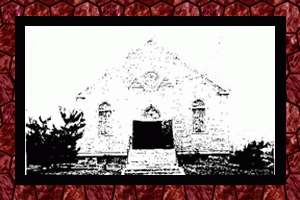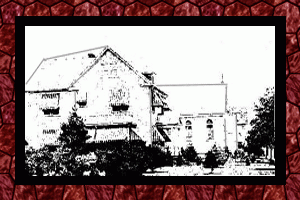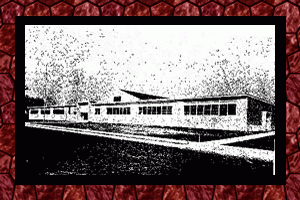Parish History
It was the opportunity of steady employment offered by the nearby farms and the local saw and grist mills that served to attract the original Catholic settlers to South Plainfield. They were predominantly of Irish ancestry, poor in the light of material possessions, but rich in the qualities of enduring value, faith, courage and the spirit of sacrifice.
The measure of their love for God and His Church is proven by their faithfulness in traveling the great distances, in those days, to Sunday Mass, either to St. Francis Church in Metuchen or to St. John’s Church in Dunellen. An examination of the early records shows that the majority of the families attended St. John’s in Dunellen.
 At the turn of the century, the Holy Sacrifice of the Mass was offered for the first time in the community by Father Edward J. Dunphy, pastor of St. John’s Church in Dunellen. From this time on they continued to enjoy the blessing and consolation of having the Holy Sacrifice offered in their midst. They began with Mass being celebrated in the different homes of the parish until the first official place of worship was located in Washington Hall on Maple Avenue. It is worthy to note that up until this time there were only twenty Catholic families living here.
At the turn of the century, the Holy Sacrifice of the Mass was offered for the first time in the community by Father Edward J. Dunphy, pastor of St. John’s Church in Dunellen. From this time on they continued to enjoy the blessing and consolation of having the Holy Sacrifice offered in their midst. They began with Mass being celebrated in the different homes of the parish until the first official place of worship was located in Washington Hall on Maple Avenue. It is worthy to note that up until this time there were only twenty Catholic families living here.
Father Dunphy acquired property and plans were initiated for the building of the first permanent church. It was completed and continued as a mission of St. John’s under the care of Father Dunphy. In 1905, Sacred Heart Mission was raised to the status of a parish and the Rev. John F. Baldwin, later Monsignor Baldwin of St. Mary’s of the Lake, Lakewood, was appointed as its first pastor.
 For fifteen years Father Baldwin resided at Mt. St. Mary’s Motherhouse in North Plainfield, serving as its chaplain, while at the same time traveling to South Plainfield to administer to the spiritual needs of his flock. These years were marked by steady growth within the parish. The day arrived when the increased responsibility called for a full time resident pastor. On September 22, 1922, Father Baldwin acquired property adjacent to the church from Thomas Savard and John Geary in preparation for the building of a parish house. In its construction Father Baldwin showed foresight – he built for the future – so that today it still serves the needs of the parish priests.
For fifteen years Father Baldwin resided at Mt. St. Mary’s Motherhouse in North Plainfield, serving as its chaplain, while at the same time traveling to South Plainfield to administer to the spiritual needs of his flock. These years were marked by steady growth within the parish. The day arrived when the increased responsibility called for a full time resident pastor. On September 22, 1922, Father Baldwin acquired property adjacent to the church from Thomas Savard and John Geary in preparation for the building of a parish house. In its construction Father Baldwin showed foresight – he built for the future – so that today it still serves the needs of the parish priests.
Large numbers of Italian families from New York City and Polish families from Pennsylvania began to settle in South Plainfield at this time. The expansion of industry, with its corresponding opportunity for employment, was the principal inducement.
With the rapid increase in population, the point was soon reached when the original Irish settlers became the smallest group and the Italians became the largest. Father Baldwin provided for this increase in his communicants by adding to the original frame building. This improvement consisted of a new sanctuary and sacristy, along with the doubling of the seating capacity.
Another accomplishment of Father Baldwin during his long years of faithful devotion to Sacred Heart parish, was the acquisition of twenty one acres of land between Clinton and New Brunswick Avenues for the purpose of establishing the Holy Redeemer Cemetery. His successors have carefully and conscientiously supervised the development and expansion of this cemetery through the years, so that today it remains one of the most beautiful in our section of the state.
With the parish facilities completely established by this time, the pastors who came after Father Baldwin diligently applied themselves to the reaping of the good harvest. It has been a rich one in good, honest, Catholic family life, and blessed with fine religious vocations.
In those years, Father Thomas A. Campbell succeeded Father Baldwin in September 1929. This was the golden age of athletic activities in the parish. Under the capable direction and inspiring leadership of Father Campbell, the sports picture in this area was completely dominated by the teams representing our parish.
The Rev. Edward A. Corrigan succeeded Father Campbell in 1934 and was followed in 1938 by the Rev. Francis J. Lyons. From the days of Father Baldwin, the Sisters of Mercy would journey down from the Mount every week to impart religious instructions to the young people of the parish. But by the time Father Lyons assumed his pastoral duties, the parish had grown to such proportions that he deemed it necessary to have resident sisters in the parish. It was with great reluctance that the Sisters of Mercy gave up this mission, for they enjoyed their work here among the children.
Arrangements were then completed for the Sisters of Atonement from Graymoor, New York, to come to the parish. A frame dwelling at 133 South Plainfield Avenue was converted into a convent and the sisters lived there for twelve years, laboring generously in the religious training of the children.
Of the many Sisters of Atonement who worked in our midst, special mention must be made of Sister Mary Paul and Sister Mary Bride. Their many years of devotion to duty and loyalty to the parish will be remembered always.
In 1944, the Rev. James G. Harding was appointed pastor of Sacred Heart Church. It was in his mind that the dreams of a parochial school were born. But before Father Harding’s hopes and dreams could be fulfilled, he was called to his eternal reward on July 8, 1951. Later in the month, the Rev. Alfred T. Sico was appointed by Bishop Ahr and he immediately began making plans for a parochial school.
Because of the building boom taking place at this time, it was decided, with the approval of Bishop Ahr, to add a new church, as well as the school. Plans were drawn up on a combination church and school designed especially for the particular needs of the parish. Ground was broken on October 1, 1952 and the cornerstone was laid in January of 1953.
 One of the great milestones in the history of the parish took place on September 4, 1953. The new school opened under the direction of Sister Mary Alma as the first superior, with an enrollment of 324 children in the first four grades. The faculty appointed to assist Sister Mary Alma was composed of four Sister of Mercy and one lay teacher.
One of the great milestones in the history of the parish took place on September 4, 1953. The new school opened under the direction of Sister Mary Alma as the first superior, with an enrollment of 324 children in the first four grades. The faculty appointed to assist Sister Mary Alma was composed of four Sister of Mercy and one lay teacher.
It was now apparent that a new convent needed to be built to adequately house our sisters. Consequently, Father Sico set out early in 1954 to build a large and spacious convent on Randolph Avenue, directly adjacent to the new school. The convent contained a chapel, kitchen, dining room, community room, study hall, baths and 15 cells or bedrooms. The third floor was left unfinished.
Before the end of 1953, it became evident that the new parish church and school were not large enough for the rapidly growing parish. Besides six masses on Sunday in the new church-auditorium, three more masses were added in the cafeteria. In 1954, one year after the 11 room school had been built, it was found necessary to construct a new wing consisting of five additional classrooms.
The population of South Plainfield soared from 8,000 in 1951 to almost 20,000 in 1963, and it now became imperative that a new church be built to take care of the enormous crowds at Sunday Mass. After permission was granted by the Most Reverend George W. Ahr, Bishop of Trenton, a meeting was held between Bishop Ahr, Father Sico and John MacWilliam, architect, and it was decided to erect a new church with a seating capacity of 1,500.
Ground was broken in March 1964, and work was begun shortly thereafter. At its completion we had a beautiful church with the main altar facing the people in accordance with the new liturgy.
